June 2009 – Volume 13, Number 1
EnglishPage.Com
| Title | English Page |
| Author | Language Dynamics |
| Homepage | http://www.englishpage.com/ |
| Type of product | English learning website |
Overview
With the consistently growing popularity and availability of the Internet, new computer-assisted language learning (CALL) programs and web-enhanced courses are emerging constantly. As a part of this trend, the number of websites related to learning English is expanding exponentially, making it extremely difficult for users to make good choices. Principles are necessary to guide educators, learners, and other Internet users in their search for reliable information and websites and to help them focus on the most relevant and valuable materials from the websites.
Principles for developing review criteria should take into account learning theories, the characteristics of the content and learners’ academic and social needs. English learning websites should observe not only the general design or evaluation principles to address learning development but also the specific ones to accomplish English learning objectives. Chapelle (2001) suggests that any proposed CALL program or web-enhanced course needs to be evaluated for its:
(1) language learning potential;
(2) learner fit;
(3) meaning focus;
(4) authenticity;
(5) impact; and
(6) practicality.
Cummins, Brown and Sayers (2007) suggest inquiring whether or not the instruction:
(1) provides cognitive challenge and opportunities for deep processing of meaning;
(2) relates instruction to prior knowledge and experiences;
(3) promotes active self-regulated collaborative inquiry;
(4) promotes extensive reading and writing across the curriculum;
(5) helps students develop strategies for effective reading, writing and learning; and
(6) promotes affective involvement and identity investment.
Since language learning is not just the acquisition of language knowledge and competence but also a process of developing cultural and social interaction and critical thinking, the principles for evaluating English learning websites should be designed to promote communication and situational learning. After reviewing different criteria for the evaluation of English learning websites, Yang and Chan (2008) show that “English learning websites should organize the learning objectives based on the interaction of the four language skills (listening, speaking, reading, and writing) and also provide learning opportunities for the semantic, pragmatic, and sociolinguistic usages” (p. 405).
As discussed above, varying criteria can be considered in evaluating English learning websites. For the sake of synthesis and convenience, this review evaluates English Page, a popular English learning website, in terms of five criteria drawn from the above literature in accordance with English learners’ academic and social needs:
(1) language learning potential;
(2) learner fit;
(3) interactivity;
(4) quality of resources; and(5) opportunities for language skills and learning strategies.
General Description
According to the front page of the website, English Page (englishpage.com) was created by Language Dynamics with the purpose of offering “free English lessons and ESL/EFL resources to intermediate and advanced English learners, typically well-educated business people and professionals, to improve their English for career advancement.” With a wide range of authentic pedagogical materials, it strives to implement online instruction of English as an alternative mode of teaching and learning and a substantial supplement to traditional teaching.
From the home page of the website (Figure 1), the “eyeball” label of englishpage.com and the graphic of a few books stacked attract learners’ attention to the concise themes of the website. They are characterized by English tutorials featuring interactive exercises and resources ranging from grammar, vocabulary, reading, and listening to student forums and online dictionaries.
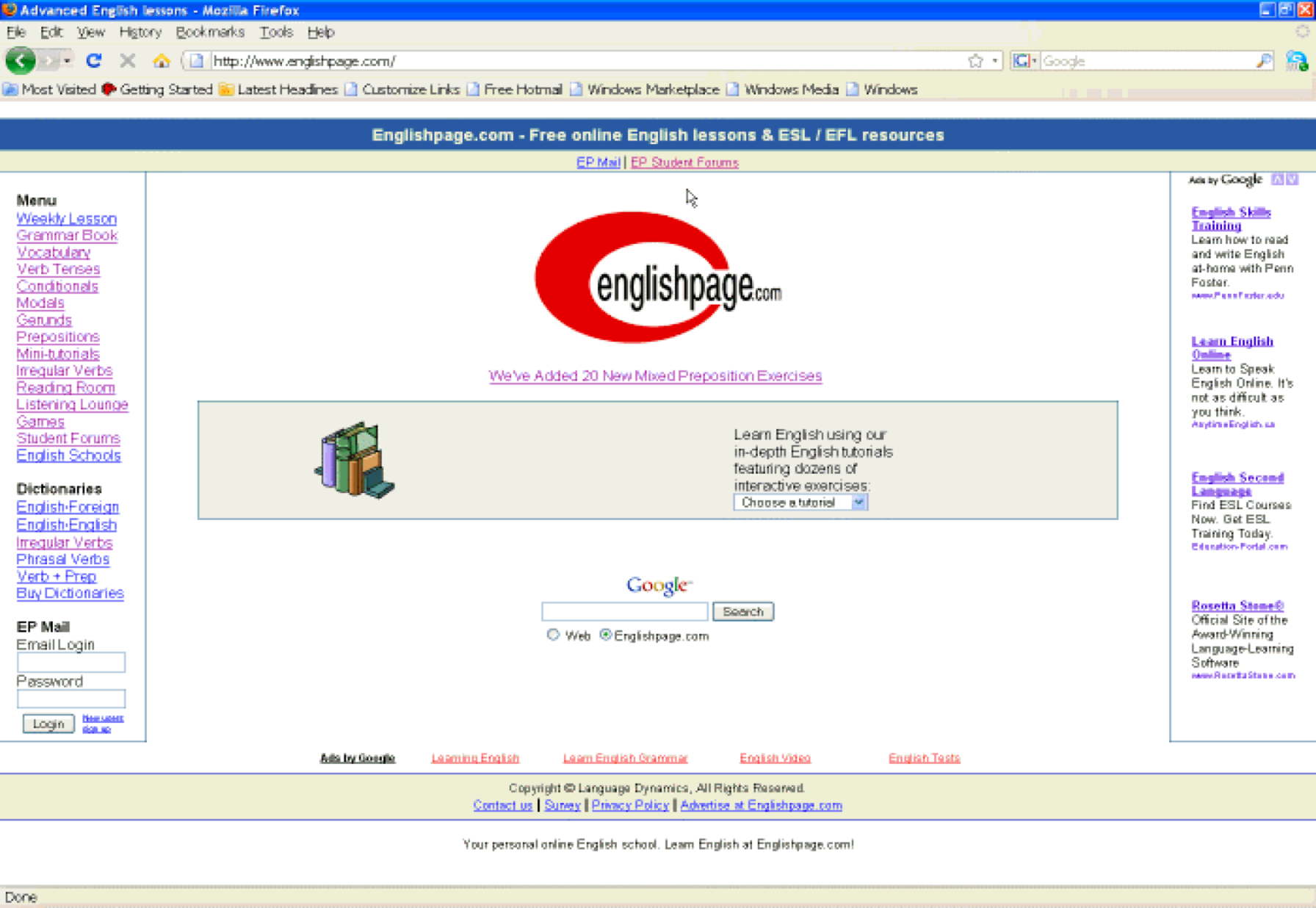
Figure 1. Home Page
One of the features of English Page is an “English Grammar Book” (Figure 2). Unlike a typical electronic book, this grammar book has 156 links to the related grammar topics within and beyond English Page. Clicking the “Add a Site” button, learners can contribute to the website by adding an English lesson, exercise, or resource. From the “Top Rated,” learners can have a glimpse of the top ten resources rated by users. Furthermore, learners can find new links to the grammar book by clicking on “What’s New.” Learners who are only interested in specific grammar points can be easily led to the target with the help of the “search” function in the grammar book or within the website.
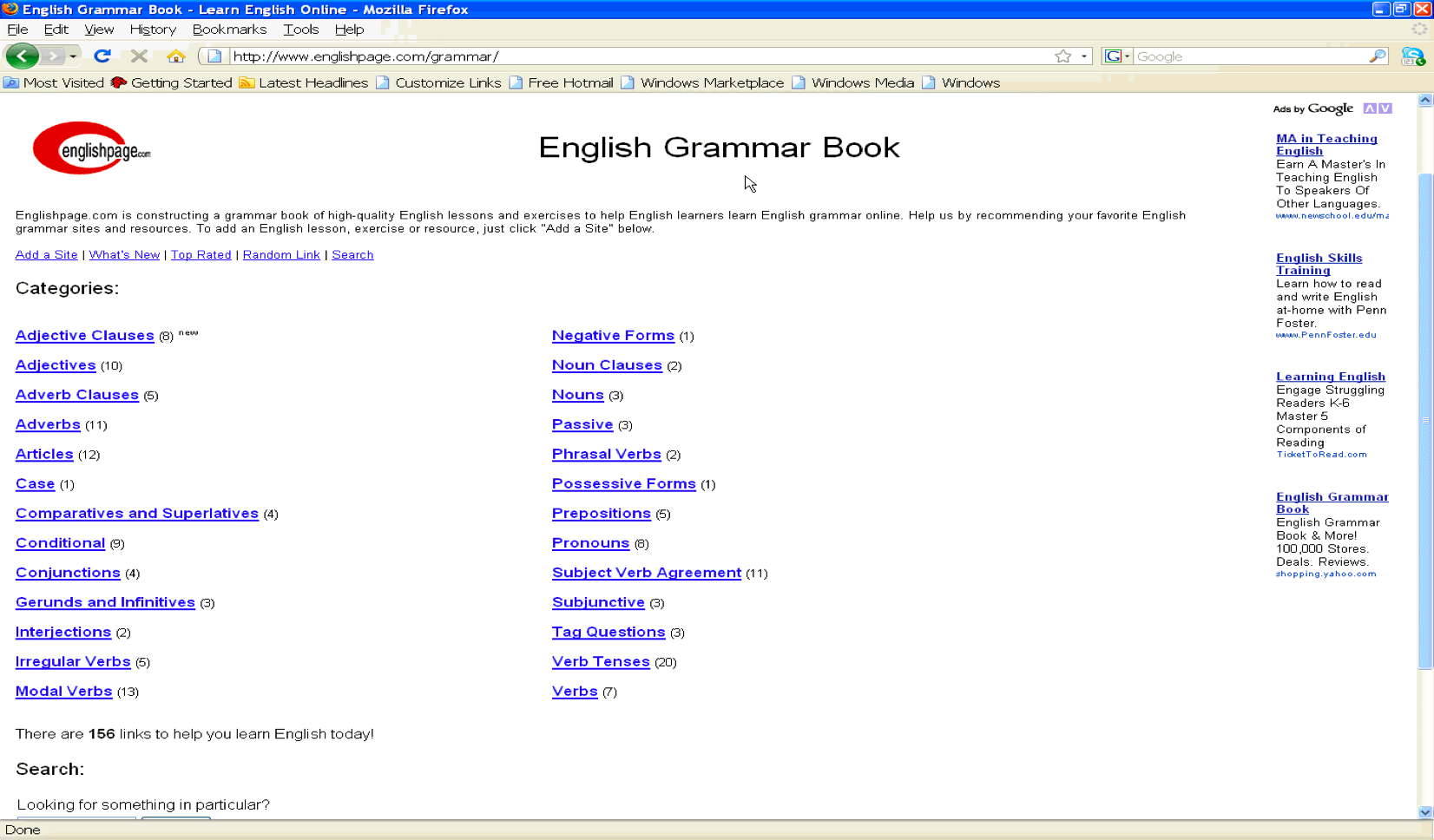
Figure 2. English Grammar Book
It is worth noting that each category of grammar tutorial features quite a few exercises, exemplified in Figure 3. In addition, not only can learners go to any exercises before or after each tutorial but also check the results using a “check” function.
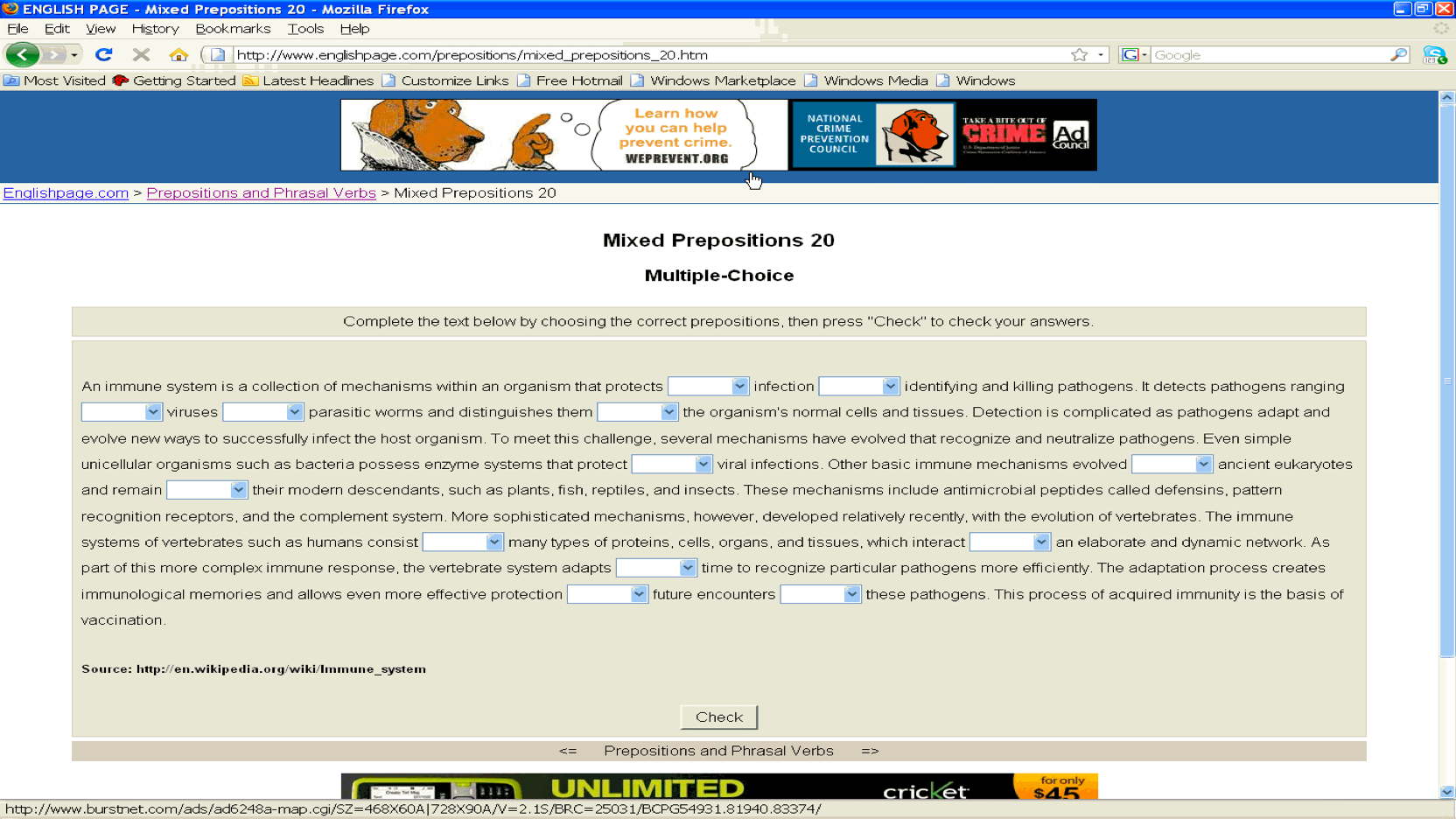
Figure 3. An Example Grammar Exercise
Like the grammar lessons, the vocabulary lessons on the site cover different categories of new words, from daily life to special fields like the aerospace industry, as shown in Figure 4.
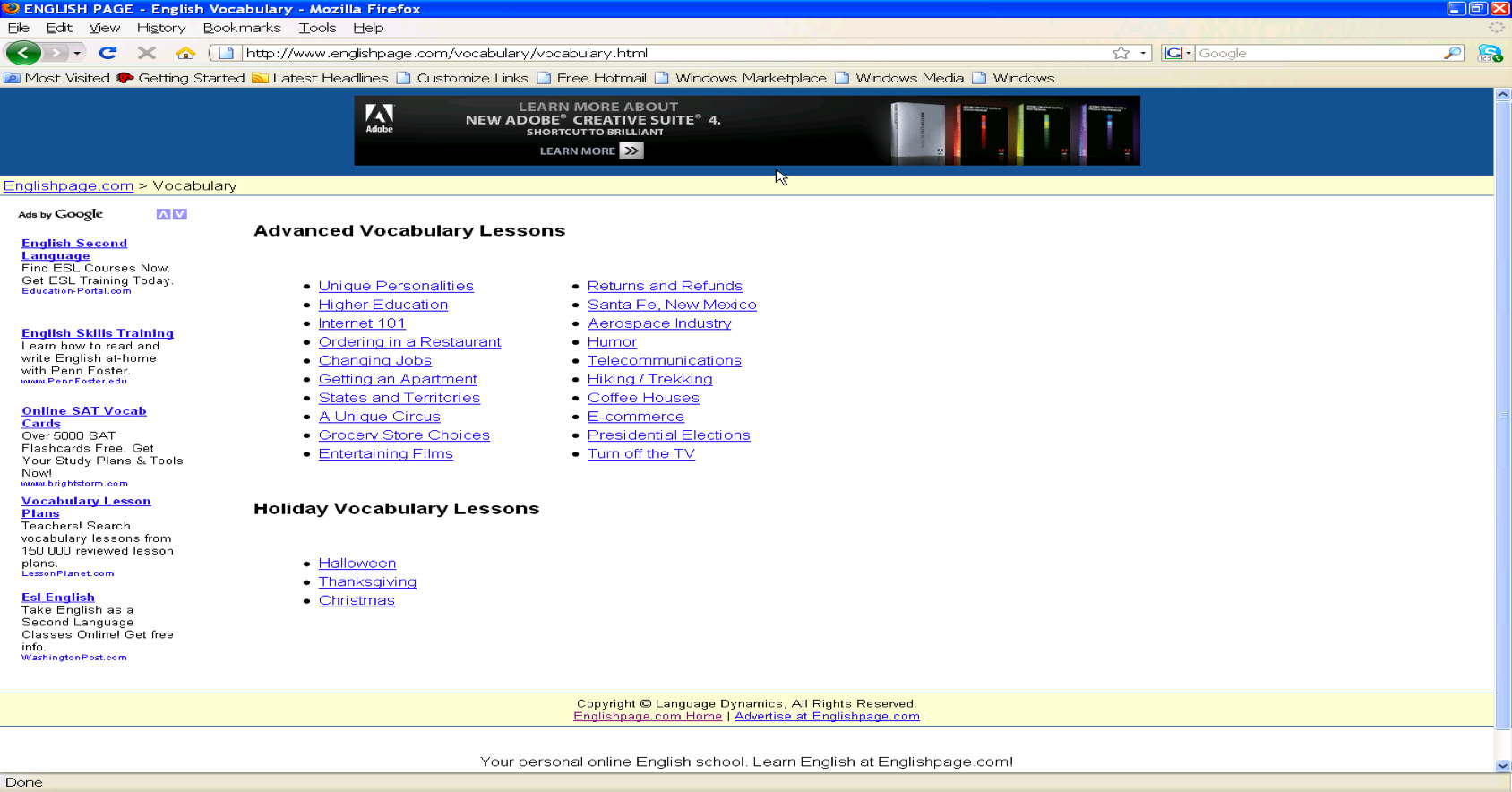
Figure 4. Vocabulary Lessons
In addition to exercises for each vocabulary lesson similar to the grammar lessons, learners can get more practice through a crossword puzzle (Figure 5).
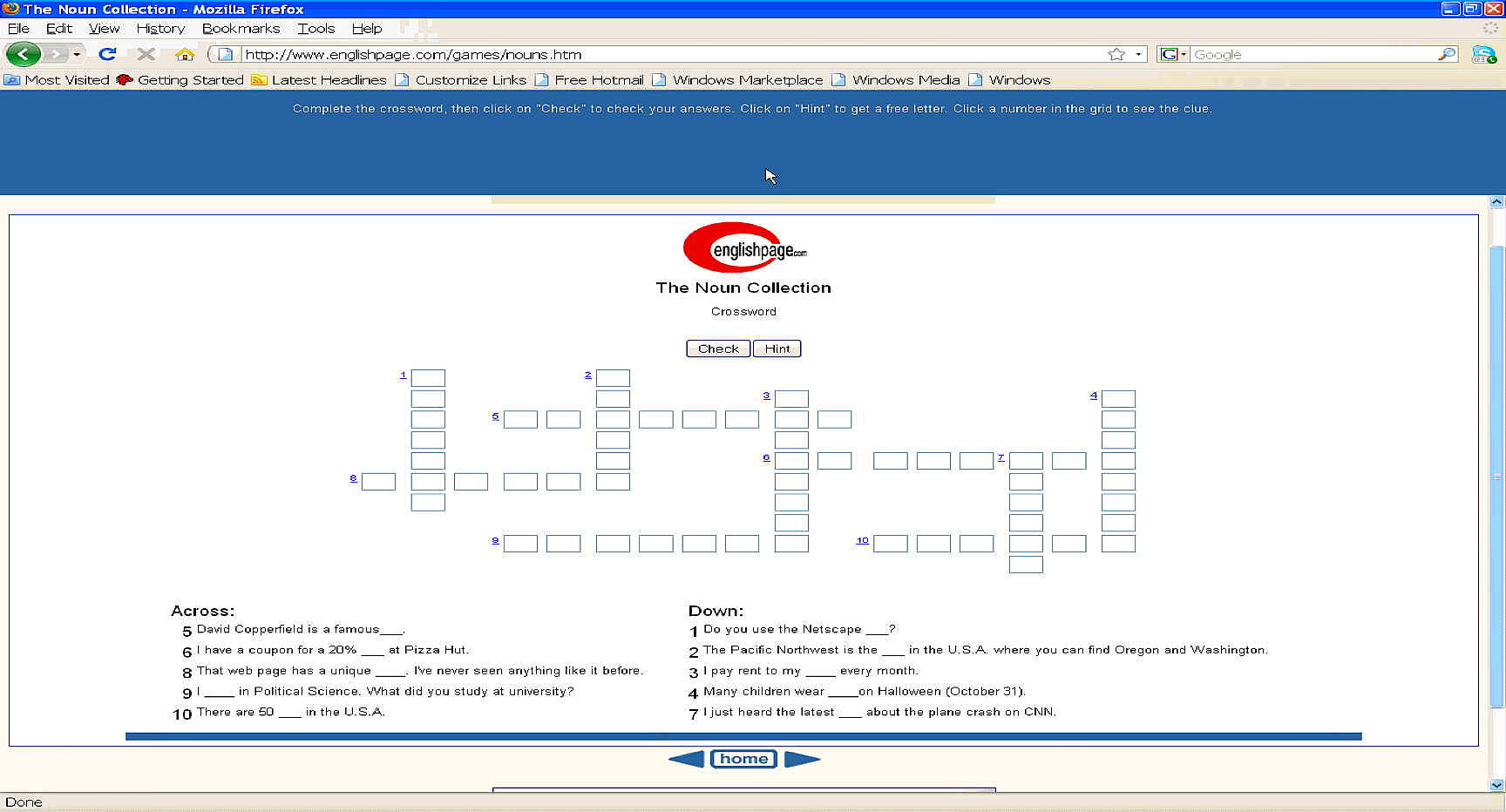
Figure 5. An Example Crossword Puzzle
Apart from English grammar and vocabulary lessons, the website offers an abundance of English learning resources for listening, reading and dictionary use. In the “English Reading Room” (presented in Figure 6), learners can harness a huge collection of online magazines, newspapers, and materials and resources from libraries. They can choose any material of their interest. Online dictionaries like English-Foreign, English-English and Phrasal Verb dictionaries are conducive to understanding difficult words and phrases whose meanings may not be obtained from the context.
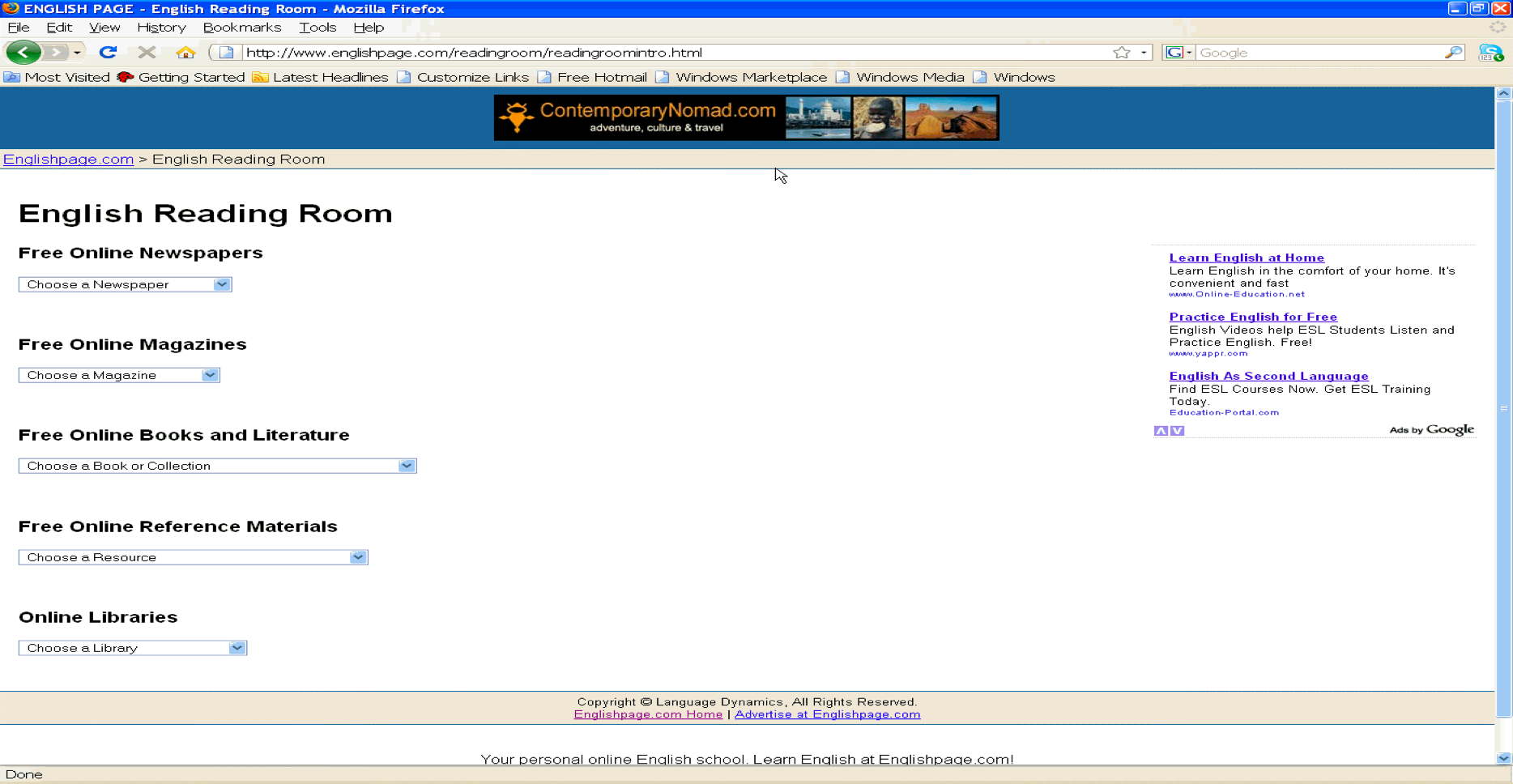
Figure 6. English Reading Room
By introducing learners to free online news, culture broadcasts, and online movies and radio (see Figure 7), English Page enables them to study English in situational settings.

Figure 7. English Listening Resources
Finally, English Page provides forums (Figure 8) as a platform for asynchronous social interaction. To enter the forums, learners are required to register before they can be involved in activities such as posting an English language question, participating in student discussions about texts and exams, or exchanging views on any topic related to learning English.
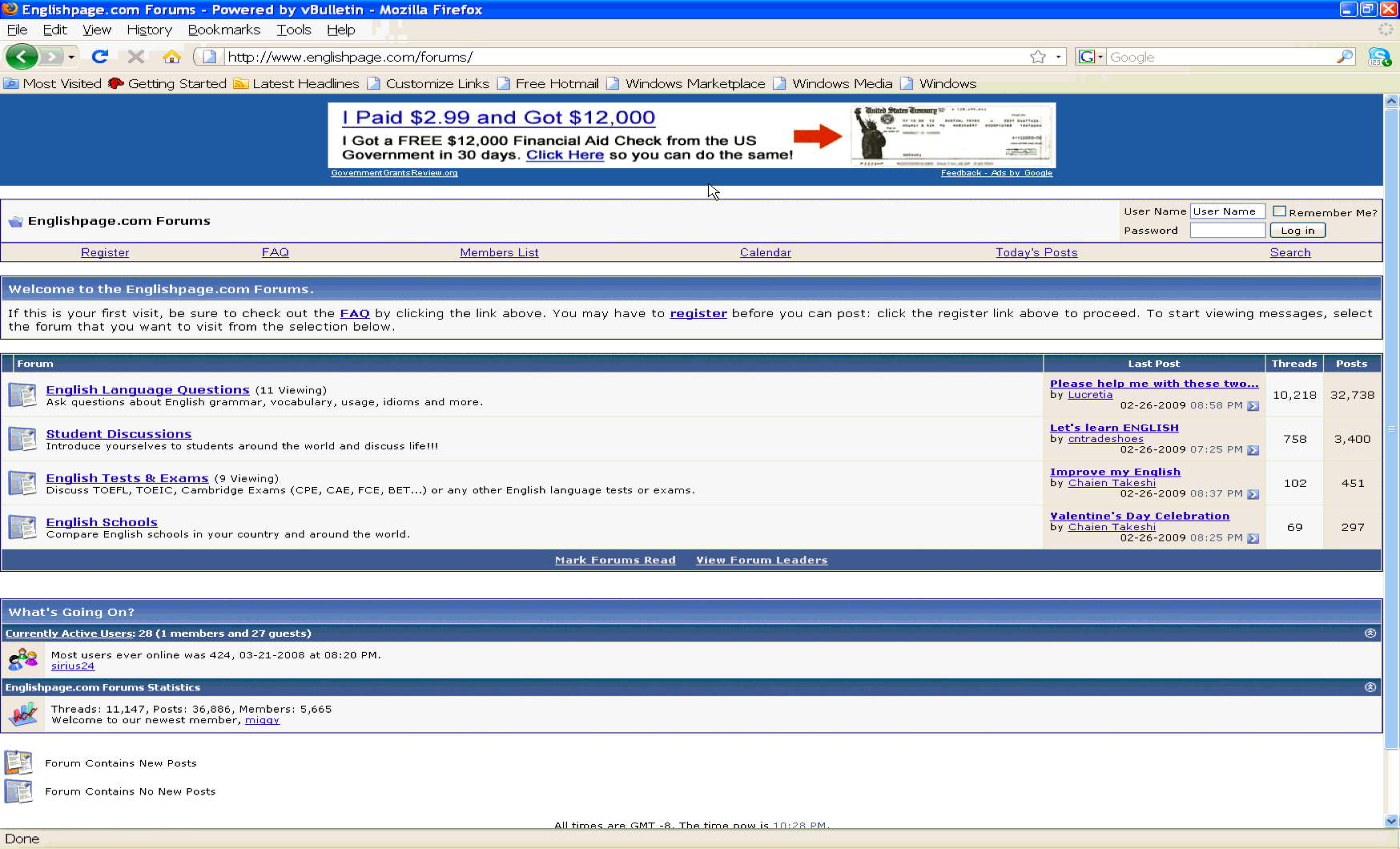
Figure 8. Student Forums
Evaluation
Based on the five criteria described previously, the potential effectiveness and shortcomings of English Page are as follows.
1. Language learning potential
Surfing the website, learners can easily recognize that English Page mainly focuses on the instruction of grammar and vocabulary skills and dictionary use, which are widely considered to be the most basic and crucial components of language leaning. With the in-depth grammar and vocabulary tutorials featuring interactive exercises, not only can learners work on the rule-governed aspects of language concurrently with the expansion of vocabulary, but also consolidate their potential for sustained growth in listening, speaking, reading and writing. In an objective manner, the properly constructed open-ended and multiple-choice cloze exercises can assess collocational knowledge of learners, which has been recognized as a crucial part of native speaker’s communicative competence (Herbst, 1996). Moreover, the popular crossword puzzles successfully incorporate phonological awareness and letter-sound correspondence into word development and meaning construction. Ignoring different assumptions as to the effectiveness of dictionary use while reading, English Page suggests that looking up words may help learners build their receptive vocabulary and can increase the chances the word will be retained (Peters, 2007).
On the other hand, in spite of the potential for language learning, without varying exercises and implementing interactive activities, English Page largely adopts a simply presented drill-and-practice approach to English learning, thereby fatiguing learners and diminishing their affective involvement. The repeated open-ended and multiple-choice cloze exercises confine learners’ acquisition of grammatical knowledge and vocabulary skills to the decoding level. To realize the great potential of grammar and vocabulary, learners need to apply them to contextualized activities such as reading and writing. Furthermore, since the website does not keep the results of exercises nor explain incorrect items, learners cannot track their progress and follow the specific areas where they need more practice.
2. Learner fit
Generally, every website follows the design principle of being usable enough to attract as many users as possible. English Page fits the needs of intermediate and advanced English learners to strengthen grammar knowledge and expand vocabulary, as well as get access to extensive reading and listening materials. It can be of interest to professionals and businesspeople who would like to improve their English proficiency in common usage. They can decide their learning process, plan their learning, monitor the learning task, and check how well they have learnt. Thanks to the convenient search functions, learners can directly reach and manipulate any materials they want to learn from within and beyond the website. As for learners aiming to become proficient at academic language, the repeated gap fill drills of grammar and vocabulary may not facilitate the integrative and complex practice of reading and writing they need.
3. Multidimensional interaction
Language learning is supposed to endow learners with language knowledge and communicative competence. English Page allows its users to participate in the development of the website by adding new links to its grammar book, rating the quality of the resources, and giving feedback to the web page developers. Thus, learners may promote their affective involvement in social practice. Besides, the website provides learners with forums as a platform for social interaction, which can have a positive impact on learners’ achievement, interest, and motivation. With some raising the threads and others giving responses, learners may experience the spirit of peer and collaborative learning. Contributing to the forum discussions, learners can enjoy the opportunities to expand their knowledge and improve their critical thinking. Considering the significance of oral English, it is a pity that learners do not have access to audio interaction in English Page.
4. Authentic resources
In addition to the tutorials and exercises within the website, learners can benefit much from other free resources beyond English Page. With links to the resources within and beyond English Page, learners can embrace extensive online situational and practical resources for reading and listening comprehension and online dictionaries. The authentic resources can invoke and build on learner’s prior knowledge and promote active and self-regulated learning. When learners can make free choices as to learning contents and control the pace of the lesson, satisfaction and engagement improve. Nevertheless, without any guidance for the use of resources, some learners may not benefit from them as much as English Page expects. Sometimes, learners may be discouraged from navigating away from the website to linked materials of interest to them because of the heavy number of clicks involved.
5. Opportunities for language skills and learning strategies
English instruction is generally aimed at the development of multiple language skills in listening, speaking, reading and writing. English Page has strived to meet the objective of helping learners to build a solid and essential foundation by providing them with an abundance of grammar and vocabulary knowledge and access to extensive reading and listening resources and online dictionaries. Through the links of the categories such as “Nouns” and “Gerunds and infinitives” in the “English Grammar Book,” the website enables learners ultimately to reach pages for the guidance and training in these aspects of English writing.
However, with its emphasis on the decoding skills of English vocabulary and grammar, English Page does not provide learners enough opportunities either for learning strategies or for language skills to help learners to foster their comprehensive English learning. Although the website offers links to an abundance of resources for English listening and reading, it does not give learners explicit instruction as to how to make use of them to improve their English learning. Despite links to writing practices, no systematic writing instruction or resources are available for learners. In addition, by lacking instruction or resources for speaking, the website fails to help learners with oral proficiency. Because of these deficiencies in some areas, learners cannot benefit from the interaction of the four language skills nor develop learning strategies such as inference, synthesis, and evaluation. The simply presented exercises of grammar and vocabulary can limit learners’ opportunities to engage in cognitive challenges and the deep processing of meaning. To help learners to develop strategies for effective reading, writing and learning, English Page needs to offer more integrated instruction of the four language skills to engage learners in efficient knowledge construction and critical thinking.
Conclusion
No website can offer all the components involved in English learning to meet the needs of all kinds of learners. English Page provides learners with substantial tutorials on grammar and vocabulary, links to authentic resources for online listening, reading and dictionary use, as well as forums for social interaction and collaborative learning. However, it fails to offer learners sufficient opportunities to develop all four language skills and learning strategies. Without extending its lessons and resources to speaking and writing, learners can neither get help with oral and written proficiency nor profit from the interaction of the four skills (listening, speaking, reading and writing) to meet cognitive challenges and promote their comprehension abilities effectively. The simply presented drill-and-practice approach to language learning, plus the repeated open-ended and multiple-choice cloze tests, may fatigue even the most engaged learners. Unable to track the exercise results or get explanations for incorrect items, English Page users must put some effort into tracking their own progress if they want to focus on specific linguistic points. Nevertheless, English Page does have a lot to offer learners in the areas of grammar and vocabulary development, and learners can make good use of the site based on their particular needs and learning goals in these areas.
References
Chapelle, C. A. (2001). Computer applications in second language acquisition: Foundations for teaching, testing and research. Cambridge: Cambridge University Press.
Cummins, J., Brown K., & Sayers D. (2007). Literacy, technology, and diversity. Boston: Pearson Education, Inc.
Herbst, T. (1996). What are collocations: sandy beaches or false teeth? English Studies, 77 (4), 379-393.
Peters, E. (2007). Manipulating L2 learners’ online dictionary use and its effect on L2 word retention. Language Learning & Technology, 11 (2), 36-58. Available: http://llt.msu.edu/vol11num2/peters/.
Yang, Y. T. C., & Chan, Ch-Y. (2008). Comprehensive evaluation criteria for English learning websites using expert validity surveys. Computers & Education, 51(1), 403-422.
About the Reviewer
Lijun Yuan is studying at the doctoral level in the Language and Literacy Program at Washington State University. Her research interests include ESL, multilingualism and technology-enhanced language learning.
|
© Copyright rests with authors. Please cite TESL-EJ appropriately.
Editor’s Note: The HTML version contains no page numbers. Please use the PDF version of this article for citations. |

